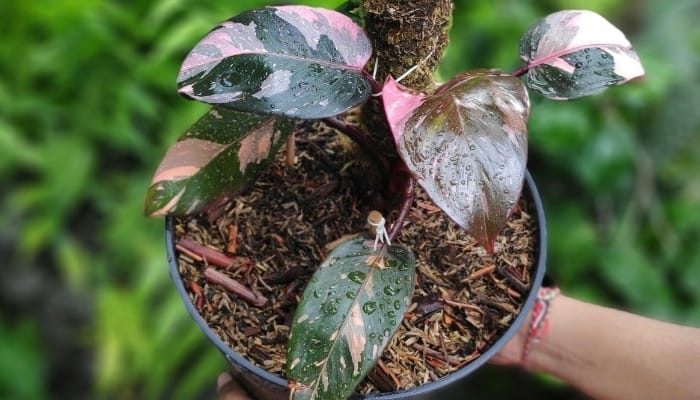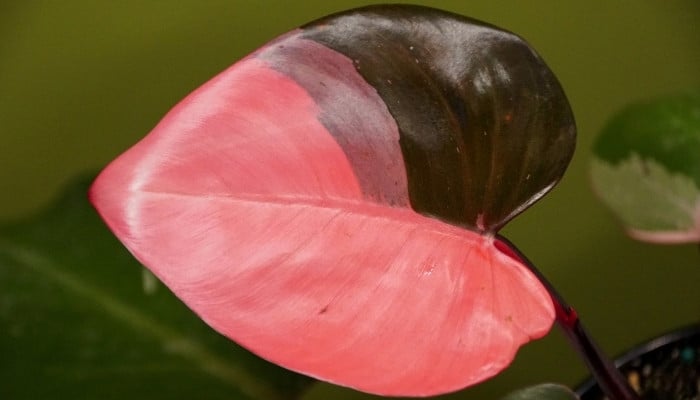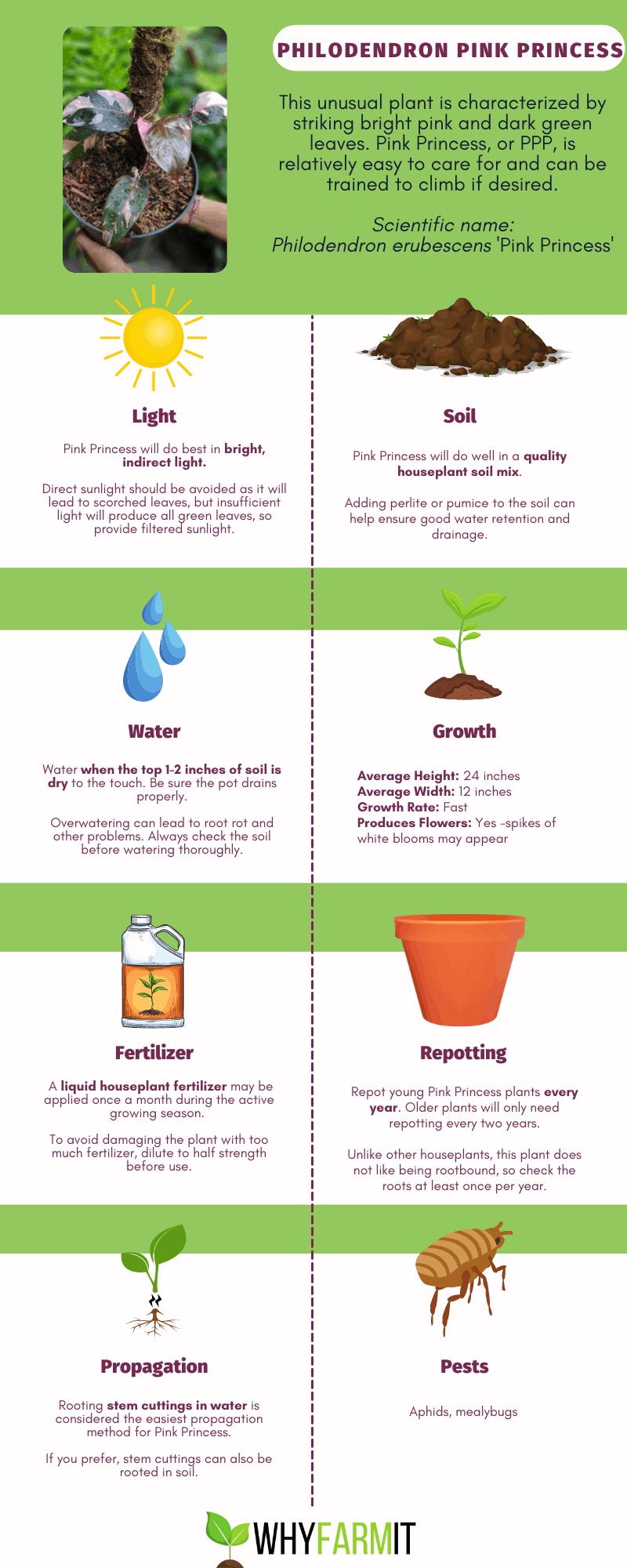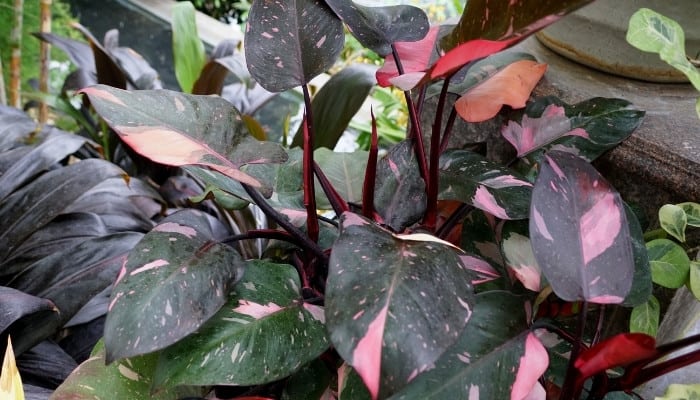Over the past several years, houseplants have piqued a lot of interest and gained tremendous popularity. However, the Philodendron ‘Pink Princess’ has experienced a dramatic surge in popularity unlike many others.
As the name suggests, this interesting plant has bright pink variegation. The coloration that makes this plant so desirable has also made it expensive and hard to come by.
How do you care for the Philodendron ‘Pink Princess’? To thrive and maintain pink-and-green leaves, it requires bright, indirect light, well-draining soil, and a half-strength dose of fertilizer once per month during spring and summer. Temperatures above 60℉ are best, and high humidity is preferred. Water when the top few inches of soil is dry.
Caring for Philodendron Pink Princess: Basic Guidelines
Philodendron pink princess is a hybrid of Philodendron erubescens.
Although the exact origins are unknown, the most common belief is that it was created by a grower in the 1970s.
It doesn’t seem to matter where it came from because those pink leaves are irresistible to plant enthusiasts.
Complete Care Guide for Philodendron Pink Princess
Most of the care requirements for Philodendron ‘Pink Princess’ are similar to the parent plant, Philodendron erubescens.
There are a few differences that help to promote variegated growth from the plant.
Philodendron Pink Princess at a Glance
- Plant Type: Tropical
- Scientific Name: Philodendron erubescens ‘Pink Princess’
- Average Height: 24 inches
- Average Width: 12 inches
- Growth Rate: Fast
- Produces Flowers: Yes
- Common Pests: Aphids, mealybugs
- Difficulty of Care: Easy
What To Do When You First Get Your Philodendron Pink Princess
If you’re lucky enough to snag a Philodendron ‘Pink Princess’, it is important to make sure it is in optimal condition.
Always check your plant for any signs of illness or pests. Check to make sure the soil drains well and that the roots look to be in good condition.
If there are any issues with the plant, keep it quarantined from your other plants until the issue is resolved.
Ideal Soil for Philodendron Pink Princess
Philodendron ‘Pink Princess’ will do well in most houseplant soil mixes. It does need to be in well-draining soil, so adding perlite or pumice can be necessary to improve drainage.
Philodendron Pink Princess Water Requirements
This plant enjoys a moderate amount of water. It is important to avoid overwatering to prevent root rot and certain infections.
Always test the soil before watering. The first inch or two of soil should be completely dry before you water again.
Water until excess moisture is draining from the bottom of the pot, and allow all the excess moisture to completely drain out.
Do not allow excess water to sit in the saucer under the pot.
Philodendron Pink Princess Lighting Needs
This plant does best in medium light conditions. Bright, indirect light will maintain attractive variegation of green and pink.
It is important to avoid direct sunlight, which can burn the leaves.
Also, too little light can cause the plant to produce more green leaves without pink variegation. This is because the low light causes the plant to need more chlorophyll for photosynthesis.
If you do not have a location to provide bright, indirect light, Philodendron ‘Pink Princess’ does well under grow lights and will maintain variegation.
Ideal Temperature Range for Philodendron Pink Princess
The parent plant of Philodendron ‘Pink Princess’, Philodendron erubescens, is found in tropical rain forests and therefore prefers warm temperatures.
Try to maintain a temperature above 60℉. Avoid drafty locations and cold window sills in winter.
Ideal Humidity Level for Philodendron Pink Princess
Philodendron ‘Pink Princess’ is fairly versatile when it comes to humidity. However, this tropical plant will thrive with higher humidity levels.
One way to increase humidity is to keep multiple plants near each other; this will increase the ambient humidity around them.
Best Location for Philodendron Pink Princess
The best location for the Philodendron ‘Pink Princess’ is in a bright room, close to a window but not receiving any direct light.
The location should remain warm throughout the year and maintain medium to high humidity.
Philodendron Pink Princess Growth Habits
Philodendron ‘Pink Princess’ is a climbing plant that uses aerial roots to hold onto trees or other supports.
It will do well on a climbing structure, like a moss pole. During the growing season, this plant can put out multiple new leaves and it grows quickly under correct conditions.
Fertilization Types & Schedule for Philodendron Pink Princess
During the growing season, use a liquid houseplant fertilizer once a month. This plant can easily be over-fertilized, so some fertilizers are best at half strength.
Stop fertilizing throughout the fall and winter when growth slows down.
Signs of Nutrient Deficiency
- Calcium deficiency – misshapen new growth, growing tip dies.
- Nitrogen deficiency – older leaves begin to yellow, entire plant loses green color.
- Magnesium deficiency – growth slows, leaves turn light yellow with dark spots.
- Phosphorus deficiency – new leaves are small, leaf tips look burnt.
- Sulfur deficiency – stunted growth, new growth is light yellow.
Pruning Philodendron Pink Princess
Pruning will help determine the shape of the Philodendron ‘Pink Princess’, but regular pruning is not necessary for the health of the plant.
If you would like a bushier plant, prune just above a node to promote new growth.
If the leaves on your plant are becoming too green or too pink, pruning can assist the plant in regaining balanced variegation. To do this, prune just above a well variegated leaf.
While all pink leaves are attractive, the lack of chlorophyll means the leaf will eventually die. So, it is important to keep a balanced variegation.
Does Philodendron Pink Princess Produce Flowers?
The Philodendron ‘Pink Princess’ produces spadix flowers. These flowers are similar to a peace lily, with a leaf furled around a stalk of tiny flowers.
The flowers are white, and the surrounding leaf is usually a deep pink color.
Is Philodendron Pink Princess Toxic?
The Philodendron ‘Pink Princess’ is toxic to pets and humans. The sap of the plant contains calcium oxalate crystals, which can irritate the skin and stomach lining.
Philodendron Pink Princess Propagation
Since these plants are so hard to come by, you might be interested in propagating your Philodendron ‘Pink Princess’ to create more plants.
Most plant enthusiasts are familiar with water propagation, and this is the easiest method for creating new Philodendron ‘Pink Princess’ plants.
Stem Cutting in Water
1. Take a Cutting
On your existing plant, use sterile scissors to cut off a piece of stem that includes at least one leaf and at least one node.
Nodes are where the leaf meets the stem. Roots and new growth can come from this location.
2. Place Cutting in Water
Place the node(s) into the water and make sure the leaf is entirely out of the water. There is usually a small aerial root at the node. This will become the first roots of the new plant.
3. Place Cutting in Bright Location
Just like a mature plant, your cutting will enjoy bright, indirect light. It is important to avoid direct sunlight which can burn the leaves and fragile new roots.
4. Wait 2-3 Weeks
You should begin to see roots forming within a week of propagation. Wait until the new roots are a couple of inches long before transplanting. This usually takes 2-3 weeks.
During this time, refill or replace the water as necessary.
5. Transplant Cutting
Once your roots are a couple of inches long, the cutting is ready to be moved to soil. Use a light, well-draining soil in a small pot.
Keep your soil moist for the first two weeks after transplanting to aid in root development.
Stem Cutting in Soil
Soil propagation is another way to create new Philodendron ‘Pink Princess’ plants. The process is similar to water propagation, except the cutting is immediately placed in soil.
It is important to keep the soil moist and maintain high humidity while the cutting is putting out new roots.
This can be achieved by placing a plastic bag over the pot and creating a small greenhouse.
Repotting Philodendron Pink Princess
Repotting is important for the Philodendron ‘Pink Princess’ to keep the roots and leaves healthy and growing. This plant will not thrive when rootbound.
When To Repot Philodendron Pink Princess
When the plant is young and establishing strong roots, the Philodendron ‘Pink Princess’ should be repotted every year.
After a couple of years, the roots will not grow as prolifically, and you can repot every two years.
A sign that your plant needs to be repotted is when the roots are beginning to circle around the edge of the pot or pop out of the soil.
You may also see roots starting to come out of the drainage holes.
Signs That It’s Time To Repot
- It’s been 1-2 years since the plant was last repotted.
- Roots are circling around the pot.
- Roots are starting to pop out of the soil.
- Roots are growing down through the drainage holes.
How To Repot Philodendron Pink Princess
1. Choose a Pot One Size Up
You might think that moving your Philodendron ‘Pink Princess’ into a large container will mean that it doesn’t need to be repotted as often.
Unfortunately, all the extra soil will hold more water than the plant needs and this can cause root rot. It is important to only move up one pot size when repotting.
2. Gently Remove Plant From Pot
Remove your Philodendron ‘Pink Princess’ from the previous pot. Shake away as much soil as possible.
This is a great time to inspect the roots and remove any dead or sick areas.
3. Partially Fill New Pot With Soil
Use a well-draining potting mix, preferably with perlite, to fill the new pot halfway.
There is no need to pat down the soil as the roots will enjoy the air pockets as they establish in the new soil.
4. Place Plant in New Pot
Place your plant in the new pot and fill the remaining area with soil. You can carefully tap the pot down to help the soil move in between all the roots.
5. Water Thoroughly
Once your Philodendron ‘Pink Princess’ has been transplanted into the new pot, water thoroughly and allow all the excess water to drain out.
During the first week, keep the soil moist to help the roots establish in the new soil.
Philodendron Pink Princess Common Problems & Solutions That Work
Philodendron Pink Princess Common Pests
With a plant as expensive as the Philodendron ‘Pink Princess’, the last thing you want is to lose the plant to pests.
The most common pests for this plant are aphids and mealybugs, but it can be affected by any of the usual houseplant pests.
Aphids
Aphids are small pests that survive by sucking the sap from the plant. They are usually found on the underside of leaves, but an advanced infestation can cover the entire plant.
Signs of Trouble
- Curling and misshapen leaves
- Stunted growth
- Sticky substance on plant
Solution
Rinse off the plant with a gentle stream of water to remove as many aphids as possible. Treat the plant with an insecticide formulated for houseplants.
Check the plant regularly and re-treat as necessary.
Prevention
There is not much you can do to prevent aphids except to keep the plant healthy by maintaining optimal conditions.
It is best to check your plant regularly and treat any aphids as soon as possible.
Mealybugs
Mealybugs are an easily recognizable pest for any houseplant owner. These white, fluffy insects tend to congregate around new growth.
Signs of Trouble
- New growth dies quickly
- Plant begins to wilt
- Sticky substance on plant
Solution
Rinse off your Philodendron ‘Pink Princess’ to remove as many mealybugs as possible.
Larger adults can be killed with alcohol on a cotton swab. Treat the plant with neem oil (I use this organic neem) or an insecticide to kill off eggs and larvae.
Prevention
To prevent mealybugs, keep your plant healthy. Avoid overwatering, as more moisture can attract them to the plant.
Philodendron Pink Princess Common Diseases
The most common disease for Philodendron ‘Pink Princess’ is fungal root rot. This is almost always caused by overwatering and allowing the soil to sit moist for too long.
Root Rot
Unfortunately, root rot starts below the surface of the soil and can be hard to diagnose early. The roots will begin to die, turning brown and mushy.
Signs of Trouble
- Stunted growth
- Base of stem turns brown and mushy
- Plant becomes unhealthy overall
Solution
Once you realize your plant is suffering from root rot, it might be too late. If there are healthy roots that can be saved, it is important to transplant quickly.
Remove any infected roots and stems. Rinse off the healthy parts of the plant and treat with a copper-based fungicide (I recommend this organic product).
It may also be beneficial to use a disinfected pot and pasteurized soil when repotting the remaining plant.
Prevention
Never overwater your plant. By allowing too much moisture to sit in the soil, you are creating the perfect environment for fungal growth.
Other Common Problems
While Philodendron ‘Pink Princess’ is an easy plant to care for, most issues arise due to lighting or watering issues.
It may take time to figure out your plant’s optimal conditions, but once you do, it should be smooth sailing.
Yellow Leaves
Signs of Trouble
- Leaves are turning yellow
- Bottom leaves affected first
Solution
Yellow leaves are most often caused by overwatering or underwatering. It should be easy to determine which issues your plant is suffering from.
Prevention
Maintain a moderate watering schedule. Allow the top couple inches of soil to dry out between waterings, and make sure all extra water drains out of the pot.
Green Leaves
Signs of Trouble
- New growth is mostly or all green
- New leaves are especially dark green
Solution
Philodendron ‘Pink Princess’ will put out more green leaves when it is not receiving adequate lighting.
The extra chlorophyll is needed for photosynthesis and keeping the plant healthy. Move your plant to a location where it receives bright, indirect light.
Prevention
Keep your plant in a location where it receives bright, indirect light. You can prune off the green leaves to try to promote balanced variegation on new growth.
Philodendron Pink Princess Common Questions

Is Philodendron Pink Princess Rare?
The Philodendron ‘Pink Princess’ is not rare, but it is hard to come by.
Variegation is not guaranteed, so many of the plants propagated by growers will not have the signature pink color.
This means that there are less beautifully variegated plants available and therefore, their price is higher.
How Much Does a Philodendron Pink Princess Cost?
A healthy Philodendron ‘Pink Princess’ will cost over $100. Plants with a higher proportion of pink coloration can go for double or triple that.
Additionally, many growers have a waiting list to purchase.
Why Is Philodendron Pink Princess So Expensive?
When a grower propagates a lot of new Philodendron ‘Pink Princess’, only some of the new plants will carry on the variegation.
The plants without variegation are not worth much, as they look the same as Philodendron erubescens.
Due to the time and resources used by the grower, the few plants that are variegated are sold at a higher price.
Learn what else makes the Pink Princess so expensive.
What is a Black Philodendron Pink Princess?
Black Philodendron ‘Pink Princess’ is not a real or unique plant.
It is a name coined by plant enthusiasts whose Philodendron ‘Pink Princess’ plants have unusually dark green leaves.
These leaves look even darker when compared to the lighter pink variegation.
How Can You Tell If a Philodendron is a Pink Princess?
The leaves on a Philodendron ‘Pink Princess’ should have a balanced variegation between pink and green.
Some leaves have more pink or more green, but no leaves should be entirely pink.
How Can I Make My Philodendron Pink Princess Pink?
To increase the amount of pink variegation on the plant, make sure it is receiving at least 6-8 hours of bright, indirect light each day.
Low light will cause the plant to put out more green on the leaves.
Do Philodendron Pink Princess Revert?
A true Philodendron ‘Pink Princess’ should not revert back to all green coloration. However, low light can cause the plant to put out leaves with less or no variegation.
Can You Grow Philodendron Pink Princess From Seed?
It is not recommended to grow a Philodendron ‘Pink Princess’ from seed.
Since this plant is a hybrid, each plant will have differing amounts of variegation and some will have none at all.
When seeds are planted, a majority of the plants will not have the pink variegation.
Philodendron ‘Pink Princess’ vs ‘Pink Congo’
Pink ‘Congo’ is a variety of Philodendron where the plants are injected or gassed with chemicals to produce entirely pink leaves.
These pink leaves will eventually die off due to the lack of chlorophyll. Without maintaining the addition of chemicals, the plant will revert back to all green leaves.
Philodendron ‘Black Cherry’ vs ‘Pink Princess’
‘Black Cherry’ is a variety of Philodendron ‘Pink Princess’ that has deep green leaves with small pink spots of variegation.
3 Key Tips for Success with Philodendron Pink Princess

1. Bright, Indirect Light
Not only is bright, indirect light necessary for a healthy plant, but it is the optimal condition for keeping balanced variegation on new leaves.
2. Moderate Watering
Do not overwater your Philodendron ‘Pink Princess’. This can lead to irreversible root rot.
While your plant can handle drying out a little between waterings, it is also important to not allow the soil to completely dry.
3. Buy a Healthy Plant
Since the Philodendron ‘Pink Princess’ is so expensive, you want to start off on the right foot. Make sure you are buying a healthy plant from a reputable grower.
If possible, try to find one locally as shipping can damage the plant.
Conclusion
For a true plant lover, the incomparable Philodendron ‘Pink Princess’ is a must-have, even with the high price point. It is an easy-to-care for plant that everyone will love.


